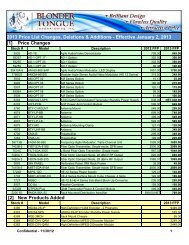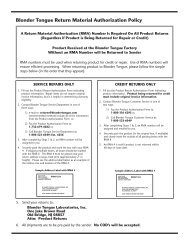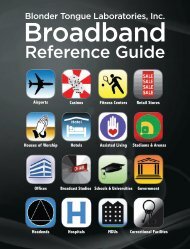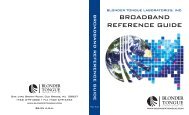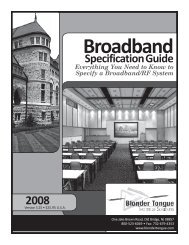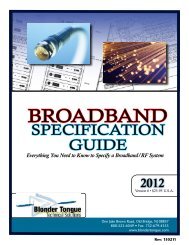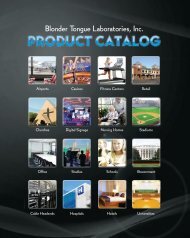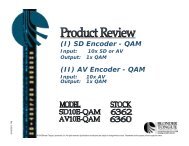US Digital Transition - Blonder Tongue Laboratories Inc.
US Digital Transition - Blonder Tongue Laboratories Inc.
US Digital Transition - Blonder Tongue Laboratories Inc.
You also want an ePaper? Increase the reach of your titles
YUMPU automatically turns print PDFs into web optimized ePapers that Google loves.
1. Terminology - Analog Standards<br />
1.1 Analog Off-Air or Broadcast NTSC Standard: Vestigial Sideband (VSB)<br />
Off-Air transmission is defined as the broadcast by a television station of a TV program that is transmitted<br />
from a terrestrial transmitter and which traverses through the air.<br />
In North America, the analog off-air programs are typically broadcast on channels 2-13 (54-216 MHz;<br />
VHF) and channels 14-68 (470-806 MHz; UHF) using the Vestigial SideBand (VSB) technique developed<br />
by the NTSC (National Television System Committee). First introduced in 1941, the original standard<br />
required 525 lines of picture information in each frame, 30 interlaced frames per second with an aspect<br />
ratio of 4:3, and frequency modulation (FM) for the sound signal. The frame rate was slightly adjusted in<br />
1953 to accommodate for color TVs.<br />
Video<br />
Carrier<br />
6 MHz<br />
Color<br />
Carrier<br />
Audio<br />
Carrier<br />
Mandated by the <strong>US</strong> Congress, analog off-air programs currently provided by full-power<br />
broadcasters in the <strong>US</strong> will not be available after midnight on June 12, 2009.<br />
1.2 Analog CATV or RF Modulated NTSC Standard: NTSC System M (NTSC)<br />
CATV transmission is defined as the transmission by a CATV service provider of a few hundred TV programs<br />
which are originated from a CATV Headend, and are distributed over a coaxial network.<br />
Video<br />
Carrier<br />
Audio<br />
Carrier<br />
In North America, the analog CATV programs are distributed using the NTSC System M modulation standard,<br />
usually referred to as RF MOdulated NTSC, whereby each TV channel has a 6 MHz-wide bandwidth. The CATV<br />
programs are typically transmitted in the 47 to 1000 MHz spectrum of the coaxial network.<br />
6 MHz<br />
Color<br />
Carrier<br />
<strong>Blonder</strong> <strong>Tongue</strong> <strong>Laboratories</strong>, <strong>Inc</strong>.<br />
1.800.523.6049 www.blondertongue.com<br />
Slide # 3



